Gathering the Threads of Matriarchal Wisdom
Weaving wisdom, knotty problems, matriarchal manifesting, sowing the seeds of love, a walking meditation, foraging for the season that's in it.
Hi, my fellow Cailleachs!
I’ve been procrastinating. I should have written to you last week, but the truth is, I’ve been feeling a bit overwhelmed.
The wars in Ukraine and Palestine, the culture wars, the war on refugees, the losing battle on climate change… so much conflict in the world, I’m sure I’m not alone when I say that sometimes it all gets too much. And that makes me feel even worse, because unlike the innocent victims of these conflicts, my family and I are safe and relatively unaffected. The senselessness of it all, the lack of political will by our elites in power, my own loss of personal sovereignty in the presence of so much suffering has melded into an inertia from which I have struggled to break free.
How are we to cope in the midst of such bleakness? What can we do or say to help the victims of suffering, when those we have entrusted with the power to act on our behalf refuse to do so? How do we continue our ordinary, safe lives while the planet burns or drowns and the extinction of species that we share this wonderful planet with accelerates exponentially as a result of human activity?
When the horrors of the Russian invasion of Ukraine first began to wash over us, on my daily commute into work, I listened avidly to the latest news on the radio. By the time I arrived at work, a ten minute journey, I would inevitably be in tears. Turn the radio off, I was advised by colleagues; whether I listened or not had no impact on what was happening so far away.
Perhaps so, but it felt like turning my back. Not listening felt like not caring. I didn’t want to live in ignorance, blissful thought it might seem to be.
Now, the situation in Gaza is just as urgent. The people of Palestine are trapped in a killing field, the ‘pause’, which is so vital in bringing much needed aid and the release of hostages, as fragile as the egos of the men in whose hands it rests.
Meanwhile, COP 28 gets under way in one of the richest oil and gas producing countries in the world, led by a man who allegedly abused his position to obtain oil deals, where world leaders will make vague promises to adhere to the 1.5*C limit without committing to reducing the use of fossil fuels.
Is it any wonder we fall into despair?
I keep myself informed, but I feel myself retreating inwards. All my old cravings re-awaken: my hands reach for comfort foods, my body seeks warmth and stillness, my mind seeks the solace of sleep. I recognise this place I’m sinking into. It’s not where I want to be.
I know that you know all this already, and probably feel the same as I do. But what would the Cailleach do? She has the power to put the land to sleep, into recovery, and she does so relentlessly every year. But the seasons don’t follow the same pattern they used to in the past. Does that mean she has become less effective, has perhaps abandoned this earth?
I don’t think so. With the rise of the Enlightenment, and the shift to more dominant and destructive forms of patriarchal control, the wresting of knowledge away from the wise-woman and the elders, the disdain for traditional skills and practices which we now realise as sustainable and eco-friendly, the Cailleach works alone, and she has become exhausted. Once, the land was populated with her human representatives, who worked on her behalf in the landscape quietly and consistently and unceasingly, tending to the land, to the animals, to the wild, to their communities: the elder women, the matriarchs, the Cailleachs, the ones men called witches.
We need to rise back into our power. But how?

Weaving words of wisdom into the every day
Yesterday afternoon, I was shopping for my oldest son’s birthday, and I came across a calendar with this quote on the cover:
START WHERE YOU ARE. USE WHAT YOU HAVE.
DO WHAT YOU CAN.
Arthur Ashe, tennis champion, 1943 - 1993.
These words of wisdom came to me just when I most needed to see them. So when I got home, I began to put them into action.
Start where you are #1
I started with a walking meditation. I needed to calm my mind, to bring order to my disordered thoughts.
There are different ways to do this; you can mark out two points and repeatedly walk between them; this works well if you want to walk within your own garden or inside your house. In a public space, it might draw unwanted attention, though. I wanted to be outside in my local area; I picked a familiar route, and decided to meditate for the first 2 km.
Seated meditations are rooted in stillness with eyes closed. In a walking meditation you are moving, and you have to be able to see where you’re going, so your eyes are open. This allows for a lot of distraction, but that’s ok. Acknowledge each bird call or plant or passing car that distracts you and gently refocus. Focus on the movement of your body: your gait, your feet connecting with the ground and then moving off again, the swing of your arms, the stretching of your muscles, your breath. Notice how it all feels.
I found this so hard, because it is the distraction of the nature all around me that draws me outside in the first place. I also love the freedom for thought and clarity it provides. It took a lot of ‘gentle refocus’ to keep me on track. But did it work?
Yes!
After the 2km, I realised that the pressure and tightness in my chest had lifted, and the tension in my shoulders had relaxed (I always hold a lot of tension in my shoulders). That was a good start. And because I had concentrated on the movement of my body, the tumult of my disastrous thoughts and lament of my inner monologue had abated. Temporarily, at least. The landscape through which I passed was so serene, I felt I was being held, its gentle loving energy rising up within me. I definitely released some emotion.
Crossing the bridge over the River Blackwater on my daily 5km walk was a lesson in itself on catastrophe, resilience and hope. A few days previously, the river had burst its banks and the whole valley lay under water. Now, you couldn’t even tell.
Start where you are #2
I took my new mantle of serenity home and promptly discarded all plans of housework and admin that had formed the schedule for my day. I wandered into the bedroom, and stared at the half-finished wall-hanging suspended beside the window. This year, my hands have been buried deep in the unfamiliar work of traditional creative arts such as weaving willow, making cordage, spinning wool and lately, macramé.
Macramé has a long history, thought to go back to thirteenth-century Arab textile weavers, and perhaps even further to the Assyrians and Babylonians. Hardly an Irish craft, then, but knotwork, I suspect, has served a function in most cultures, from creating nets for fishing to bundling produce, for example.
Although technically an ordered entanglement of knots, macramé is much like weaving, and I find it a meditative process, one which my fingers can move over of their own accord, freeing my mind to pursue its own interests, at other moments calling me back when concentration is needed, mind and hands required to work together in concerted effort.
I remember watching my mother at her macramé when I was a child, on the veranda of our home in Cyprus, rolling canary warbling away at her side in a little wooden cage suspended from the roof. She used to make wall hangings and plant holders for her many plants, inserting odd bits of wood and pottery she found to add interest. I never thought that one day I would discover so much contentment in the same creative art as she did. My mother is not the same person she was before her strokes; she is fairly unreachable, can’t really talk or move much. Following her into this craft somehow reconnects me with the part of her that I feel I’ve lost.
Use what you have.
I went on a foraging walk this morning. Every year at this time, I order a huge wreath for my front door. I love it, but I don’t love the price tag. Why was I outsourcing this joyous activity of going out into the landscape and bringing its gifts into my home?
This year, I have decided to make my own. Flower arranging is not really my thing; for a start, I prefer my flowers alive in the ground rather than dying in a vase. Also, I just don’t have the talent for it. But I’m going to give it a go.
In the video below, you can see what I found. Most of it had already been cut down, apart from the spirea and the snowberry, which is plentiful around here, and the hazel and sycamore. Tomorrow, I will gather some moss (I have loads in my garden) and some other bits and bobs. Then I will be ready to begin building my wreath.
Have you ever wondered why we hang evergreen wreaths on our front doors at Christmas? The circular shape of the wreath shows no beginning or end, and thus symbolises continuity and renewal, and also represents the wheel of the year
At this time of year, we think of it as a Christian practice in celebration of the birth of Christ, but it has much earlier roots. People have always cut boughs from evergreen trees and shrubs and brought them inside to decorate their homes at the Winter solstice. Why? Let’s think about it…
The Hardship of Winter
It’s the middle of winter; it’s dark, cold, wet and maybe frosty or snowy. All the deciduous trees and plants have died or are hibernating. Crops cannot grow in frozen or flooded ground. The food stores are running low. Many animals are hibernating or have migrated so even hunting for food is difficult. The days are short, the nights are long. Life seems to have slowed. It’s certainly more full of hardship than it ever was before.
Yet despite the ‘death’ of winter, the evergreens continue to push stoically through the snow, bracing their stunning shield of vibrant green against the cruel onslaught of winter. How did they flourish in the deep dark season, when all else hid or failed? What magical powers did they possess which ensured their survival? These plants must surely be blessed and full of potent power. They must have been seen as a sign of hope, and a promise of new life to come in the lush and bountiful impending spring and summer.
Sacred Evergreens
In particular, mistletoe and holly were greatly venerated by the Druids. Mistletoe, despite being poisonous to humans, was thought to bring fertility and healing. When found growing on an oak tree, it was considered especially powerful, and would be gathered on the 6th night of the full moon after winter solstice. It was hung over doorways to ward off evil.
Holly was another plant sacred to the Druids. With its glossy green leaves and bright red berries, it’s hardly surprising. Although poisonous to humans, its leaves and berries were believed to have medicinal properties, and it was also hung up in the home for protection.
Symbol of Hope
Bringing the greenery indoors not only served the purpose of brightening the home and bringing good cheer, but was a symbol of hope for the future, and perhaps shared its magical powers and protection with those who dwelt there. Yet it seems the trees themselves were never cut down and brought inside as we do; people merely removed branches and sprigs. Perhaps to cut down and kill something which showed the only signs of life during the death of winter was seen as a bad omen.
We Weren’t the Only Ones…
The ancient Irish and Celts weren’t the only people to carry out this practice. The ancient Egyptians used palm branches for the same purposes, and the Romans decorated trees with bits of metal and images of their fertility God, Bacchus, at the festival of Saturnalia, which began on Dec 17th and lasted until just after the solstice.
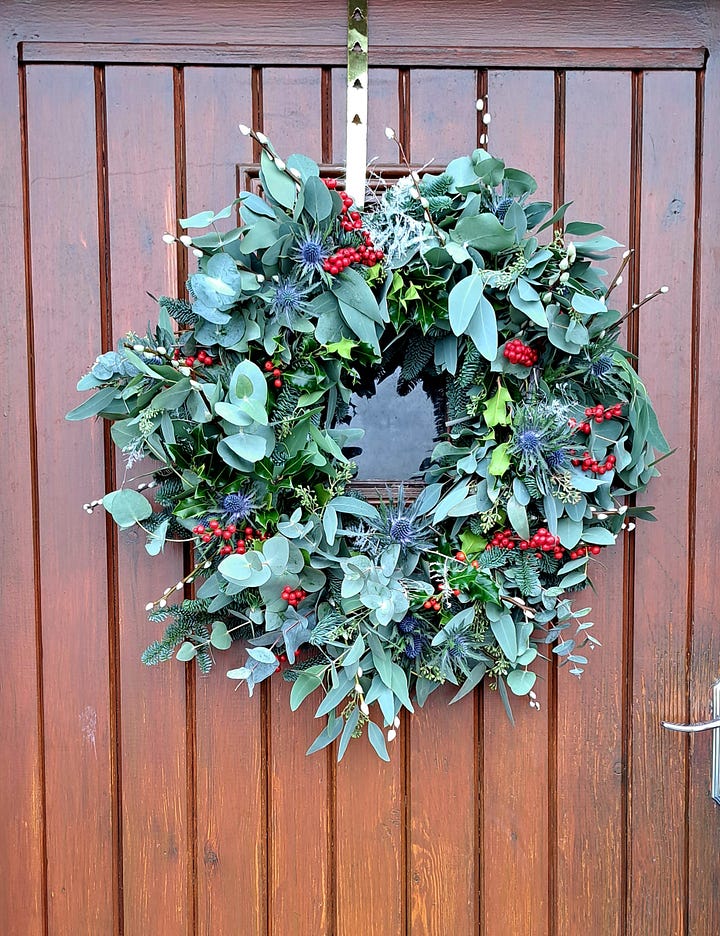
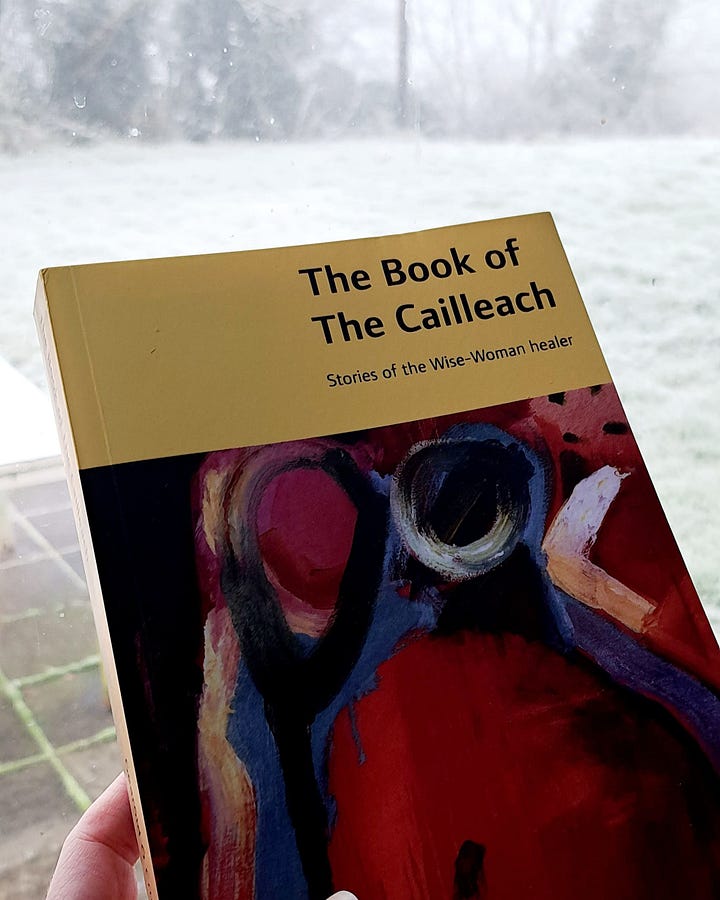
Do what you can
Making my wreath - looking after my family - sowing seeds I have saved from the wild - walking my garden and the land - feeding the birds - trimming my hedges - working my macramé and other crafts - learning from tradition - reading, for pleasure and developing my awareness - these are the simple things I do to keep my sanity in these challenging times. They are not looking away. They are not ignoring. Life has to go on. Self-imposed torture helps no one.
But neither do they ease the suffering, they don’t change the world. That’s not something I can do on my own. It’s not something any of us can do alone. So what can we do?
Make donations to organisations that are on the ground where they are needed.
Write to politicians.
Sign petitions.
Participate in awareness campaigns.
Join protest marches and movements.
Self-educate.
Bear witness.
These are just some of the things we can get involved in, which help us to feel less helpless and more pro-active. I have been putting off writing about it because you don’t need to be told what you already know. I didn’t want to make this space political. But everything we do/ choose not to do is a political act.
Also, writing is what I do. I didn’t take a Masters in Literatures of Engagement just to ready pretty words by other authors; I chose this course because writing, and all the arts, have power. They reach where the bland duplicitous words of many politicians can’t. It’s why I wrote a book about disability, mothering and female aging. It’s why I write H A G. Writing, whether poem or book or screenplay or music score, is about using your voice and bearing witness. It is our responsibility to keep our eyes resolutely and steadfastly on the events happening around us, to acknowledge the atrocity, and to record it using whatever skill we have so that in the future, when these events are rewritten to suit the existing political narrative of the time, the truth still circulates. We can’t stop these things happening, but we can bear witness, no matter how painful it is for us to do so.
Matriarchal Manifesting
I don’t remember which year it was, but in the recent past there was a call on Facebook for people around the world to pray for rainfall in Australia to end the terrible wildfires which had raged there. We were all asked to pray together at a particular point in time in whatever faith we hold. I am not a religious person (I call myself ‘spiritual without religion’, and that works for me), but I do believe in the powers of manifesting, so I took part. It felt incredible to know that all around the world, as I sat at peace in my bedroom, people were praying together for the one thing, at the same time. It lent me energy, and I don’t think I have ever ‘prayed’ so fervantly before!
And it worked. The rains came.
Imagine if we did the same thing to end war.
In Ireland, on the 6th of January, we celebrate Nollaig na mBan, a ‘Women's Little Christmas’; women get together to relax after their hard work over the Christmas celebrations, while the men stay at home and do the chores and mind the children. Often, special women’s events are held. I ask the universe for world peace and concerted action on climate change most days, but I will be using Nollaig na mBan as a special day to focus on these issues, and again on St Brigid’s Day. Women’s power is different to men’s, and on these special women’s days, I believe our prayers and vigils and strengths will be extra powerful. You are welcome to join me, if you wish.
Thankyou for reading! Blessings of the season and hugs to you all,
Ali xxx
The power of women who travelled from all over Ireland at Lughnasa to form a circle of protection around Cairn T, Loughcrew, at Lughnasa 2023, a spectacle I will never forget.


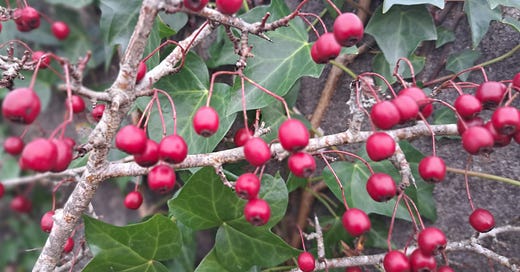




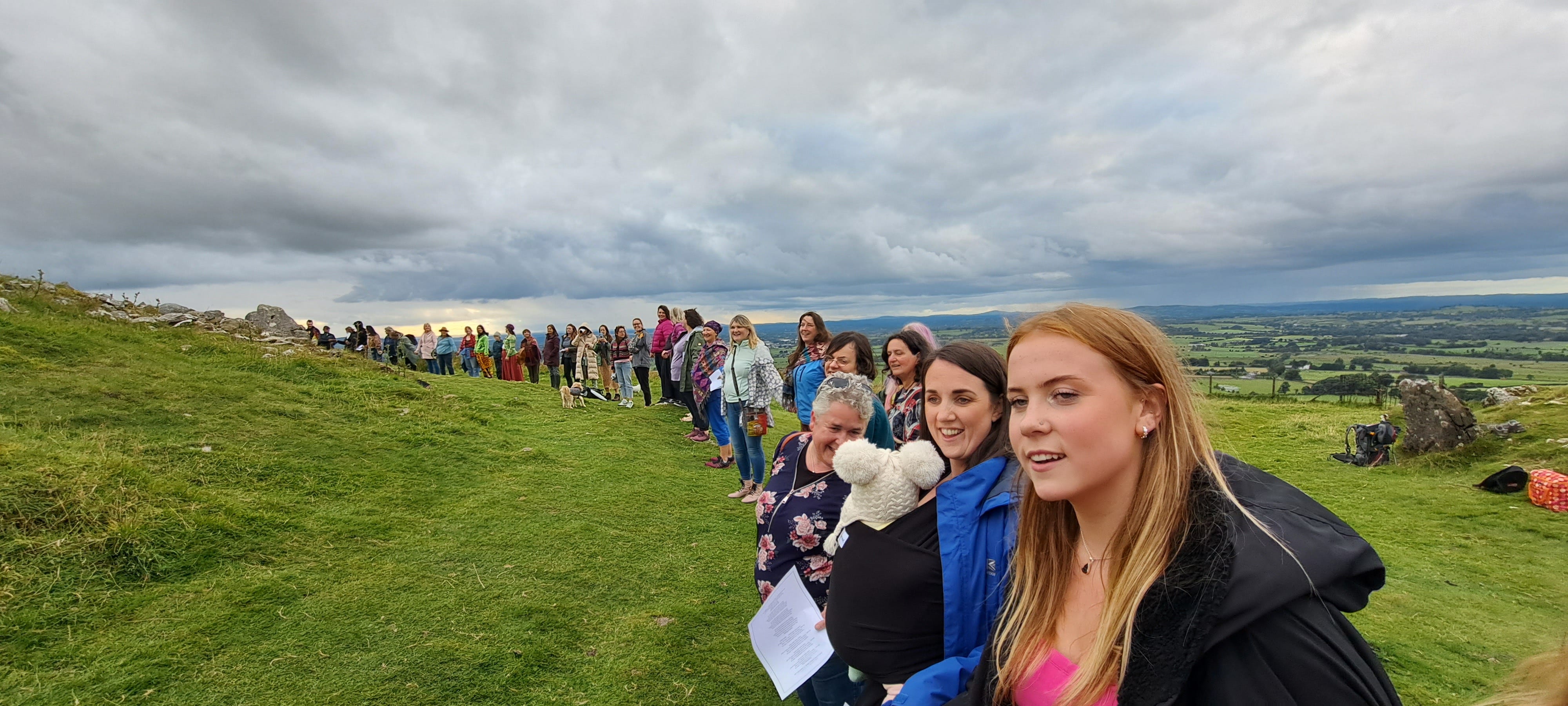
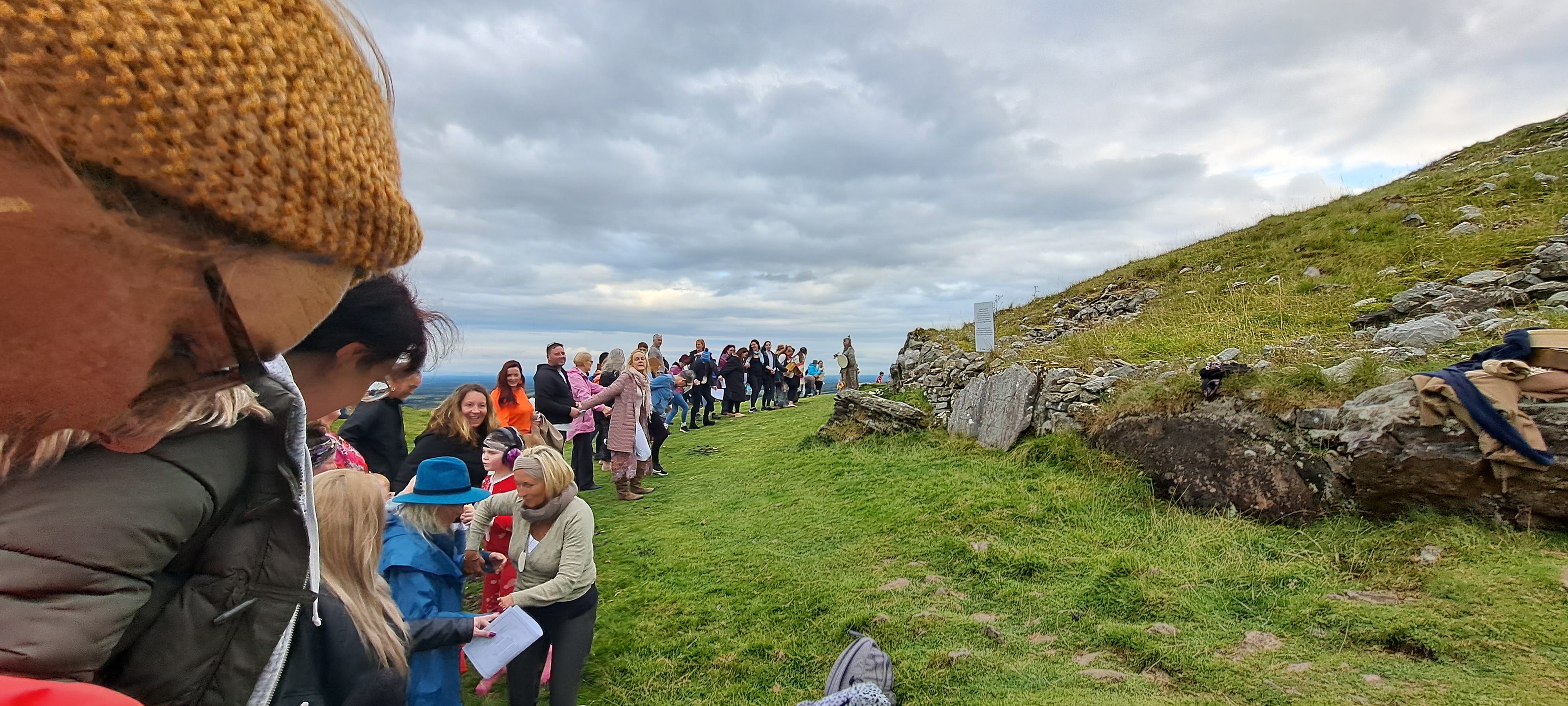
Wonderful how you wove this from despair to a personal resolve of ‘start where you are’, ‘use what you have’
I think we forget that as little as 20 years ago we did not have instant access to world new as it happens, so I think we were more focused on what is around us, what we can sense, what we can touch, and what we can actually do.
Though world events, as reported, are horrific, I believe our attention on scrolling, reading and contemplating them takes us away from where we are, and that constant disconnection can cause us all kinds of problems. We can be anxious and pine for better lives for people 1000s of miles away, while someone in our village is laying helpless having heart attack and nobody notices.
I suppose my personal thoughts, after experiences of being a political candidate, is we can be more effective what is around us because its’s easier to recharge our wholeness with what’s around us and return to being strong again to handle things.
I love your idea, and encouragement, of using the upcoming ‘ladies days’ to bond a focus, a prayer focus, meditation focus, on painful world issues to be part of the umbilical feeding that I feel so drastically needs to be returned and respected.
Precious Ali, Thank you for putting words to my pain and guilt for what's happening around the world. Last night, as I got into my snug, warm bed with a nice heating pad for my shoulder, and I was expressing thanks for my comfortable life, I couldn't help feeling sad and guilty that I had the luxury of clean sheets, a functional bathroom next to my bedroom, a full pantry, and nobody shooting at me or dropping bombs on my head. I have had to step back from NPR and give myself a break. I had to remind myself of the regular contributions I make to my local causes. I can only do what I do.
I get into an angry litany of how our leaders should grow up and serve the people by stopping all this discord. I love that you have the wonderful suggestion of a walking meditation to calm the mind. Thanks for the description of how to do it.
I agree that the Celts would never commit the crime of cutting down a tree for the holidays, but would, instead, clip branches. I clip and bring in juniper branches, and I find places around the house to place them, then add pretty holiday balls and strings of beads to decorate them. I check throughout the season for mistletoe, clip it, and tie it up with red ribbon. Ah, it's fun to think about that when my house is currently full of boxes, both packed and those waiting to be packed. Next year.
In years past, when not preparing for a move, I have held wreath-making parties at my house. Everyone brings her own frame, handmade or bought, and supplies to share - greenery, ribbons, beads, holiday balls, scissors, etc. I lay out sheets on the floor for us to sit on, which makes clean up easier. I put out a couple of hot glue guns, wire cutters, lots of juniper branches, pine cones, acorns, wires with large baskets and bowls for everyone to dump their collection in and we "go to town." The creativity that shows up always thrills me. Everyone goes home with her own treasure.
Thinking of you and hoping one day to spend Yule in Ireland. And I will be with you Irish ladies in spirit for Nollaig na mBam. Many blessings to you.